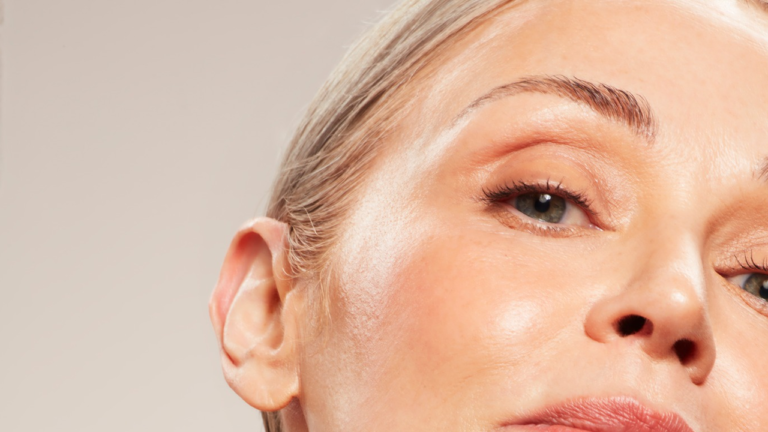Type: Body BrushEffects: Exfoliates and removes dead skin cells for glowing, smooth skin.Specifications: Brush made from pure natural sisalBest for: Exfoliating, Increases circulationHow to use: Apply to dry skin before bathing or showering. Start at the feet and brush upwards towards the heart. Brush using small strokes or circular motions for 3-5 minutes.
Best for Skin Care Absorption: Droplette
Why we love it
Droplette’s Microinfusion Device is an essential beauty tool in Brooke Shields’ beauty routine. This egg-shaped wonder aims to infuse ingredients right where they’re needed at a molecular level, essentially making them more effective than topical applications. The process works through an aerosol mist that sprays tiny droplets that get past the skin barrier. Shields opted for the brand’s collagen supplement, but they also have a range of capsules to treat a variety of other ailments, including glycolic acid, growth factors, and retinol.
Editor’s Experience: “Have you ever thought about how much product you waste by just applying ingredients to the surface of your skin? I never thought about it until I tried Droplette and felt my skin really improve over time (more hydrated, less redness, plumper and firmer). Skincare is expensive, after all! It also comes with hyaluronic acid-based lip plumping capsules that I use before big events for an extra boost. I’m too scared to get lip fillers.”—Iman Balagam, Contributor Type: Skincare Device Pros: Needle-free technology that delivers ingredients like collagen and retinol 20 times deeper into the skin. Specs: Micro-infusion technology, charging adapter Best for: Skincare absorption, plumping, hydration How to use: Place serum capsule into chamber until it clicks. Then tilt your head back and hold the white side about 1.5 cm away from your skin. Turn device on and move mist in slow, circular motions around your face. The brand recommends starting from your right cheek to your chin, then working your way up to your left cheek to your chin, and finally finishing at your forehead.
What is the difference between the various beauty techniques?
LED Light Therapy: According to New York City-based aesthetician Elizabeth Hand, LED light therapy is a non-invasive skin care treatment that uses specific wavelengths of light to address a variety of skin concerns. “It’s important to look for devices with both red and blue light, as these lights penetrate the skin at different depths and have different effects,” she advises. Red light stimulates collagen production and promotes healing and repair, while blue light destroys acne-causing bacteria. Microcurrent: “Microcurrent technology delivers low levels of electrical current to tone and shape facial muscles,” Hand explains. These currents mimic the body’s natural electrical impulses to improve muscle tone and firmness. Cryotherapy: “Cryotherapy is any form of treatment that exposes the body to freezing or near-freezing temperatures for a short period of time to achieve a therapeutic effect,” Hand says. “The cooling reduces inflammation and swelling, resulting in a more refreshed appearance.”Facial Massage: Facial massage is a technique that uses hands or specialized tools to gently manipulate the skin and muscles of the face. It stimulates blood flow to deliver oxygen and nutrients to skin cells, promoting healthy, glowing skin. Plus, it helps remove toxins and excess fluids through the lymphatic system, reducing puffiness and swelling. “I tell my clients this is the easiest skin care you can do at home,” says Hand. Laser: Lasers, specifically the Lima Laser, are the first FDA-cleared at-home lasers. Clinical trials have shown they reduce signs of aging, wrinkles, redness, age spots, scars, hyperpigmentation, and more. “The laser reaches deep into the basal layer of the dermis, where the light energy triggers gene switches in skin cells that tell them to recharge, regenerate, and repair rather than die,” Hand explains. “Externally, the light energy of the Lima Laser tells existing cells to produce more proteins to fight free radicals, increasing collagen and elastin,” Hand continues. Microneedling: Microneedling, also known as collagen induction therapy, is a minimally invasive cosmetic procedure that uses thin needles to make tiny holes in the skin. “These micro-injuries stimulate the body’s natural wound-healing process and increase collagen and elastin production,” explains Hand. Dermaplaning: “Using a scalpel, dermaplaning removes the top layer of vellus hair (peach fuzz) and dead skin cells, resulting in smoother skin and better product penetration,” explains Hand. How often you should dermaplan depends on your hair growth, but once every two to four weeks is usually recommended, she advises.
How do you choose the right beauty tool for you?
Hand says it all depends on your goals, concerns, and timing factors. Are you preparing for a wedding? Heading off on vacation? It’s important to consider all of these factors before incorporating the right beauty tool into your routine. She recommends consulting with your esthetician and finding out which tools experts highly recommend for at-home use. “I always recommend LED masks as the No. 1 at-home tool that anyone can benefit from.”
Is it worth investing in at-home beauty tools?
Hand is a big supporter of at-home beauty tools, but stresses that “as with any supplemental skin care, no tool is a substitute for a good skin care routine.” If you’re using them at home, he recommends avoiding dermaplaning or microneedling, as the downsides (bacteria, damaged blood vessels) outweigh the benefits. “Leave those to the pros!”


